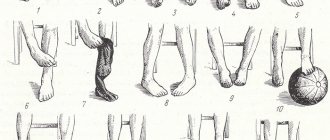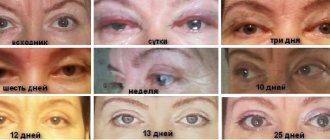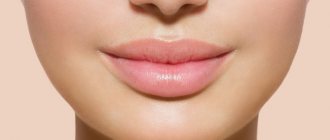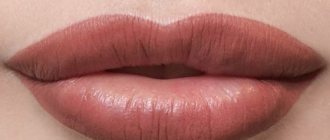Rhinoplasty is a plastic surgery procedure to correct congenital or acquired defects of the nose. With the help of surgery, it is possible to eliminate problems associated with nasal breathing. The procedure can be performed for aesthetic reasons.
After rhinoplasty, the upturned tip of the nose is corrected, also if it has an excessive length or a hump, a saddle shape, or wide large nostrils. There are several types of rhinoplasty, the rehabilitation process after which varies from day to day. Possible use of open or closed method. To clarify the specifics of nasal reconstruction after plastic surgery, make an appointment with a surgeon at the Medial clinic.
Examples of consequences after unsuccessful rhinoplasty
Aesthetic consequences
- The stitches do not heal. This is due to the individual characteristics of the body. If you know that you have slow tissue regeneration processes, it is better to inform your surgeon about this
- Swelling does not go away. Here the reason may be both in individual characteristics and in the skill of the surgeon. Another “X factor” is anesthesia. You can read more about this in my article.
- Nose too small. This happens because the surgeon removed too much tissue. But sometimes due to the fact that expectations do not match what is received
- The effect is too weak. Most often this is a psychological problem after rhinoplasty. When the patient thought that after rhinoplasty it would change dramatically, but in the end, aesthetic corrections simply made a beautiful nose. But they didn’t make the whole patient beautiful.
- It is clear that the nose is “made”. I also chalk this aesthetic problem up as a result of unsuccessful rhinoplasty. Because after plastic surgery the patient must “wear” a natural nose, not a doll one.
A little history
The injection rhinoplasty technique came to us from Asia. The inhabitants of this region are characterized by small noses with almost no bone or cartilage support. The attractiveness of European noses led Asian specialists to think about using injectable fillers and thereby creating new facial features in their patients.
In Russia there is a completely different racial feature - the Slavs often have large and fleshy noses. Additional volumes do not always color them, giving the appearance of Pinocchio with an overly upturned long nose...
Before administering the gel, the doctor must carefully evaluate the patient’s initial data and make sure that this technique is really suitable for him.
Functional consequences of unsuccessful rhinoplasty
- Labored breathing. This problem rarely occurs after, and more often before, surgery, but you still need to carefully monitor your breathing.
- Painful sensations. I will not expand on this issue, everything is clear here.
- Loss of smell. When you stop smelling, it's as if you have sinusitis.
Possibilities of injection rhinoplasty
Imagine a sculptor - this is your cosmetologist. He has a model in his hands - your face - and some more material to work with (hyaluronic acid gels). Hyaluronic fillers always increase tissue volume. But in non-surgical rhinoplasty, filler injections smooth out the transition between the forehead and the bridge of the nose, fill the dimple on the nose, and create support at the base of the nose, lifting it.
A cosmetologist cannot make the nose smaller, but he can make it visually straighter, upturned, hide the hump and draw a straight line, creating a play of chiaroscuro, an optical illusion. True, such a trick cannot be performed with every patient.
To find out whether injection rhinoplasty is right for you, use the following tip: if your nose is large and has previously been injured, a deviated septum and impaired breathing, then surgical rhinoplasty is the clear choice.
Most likely, you will need the help of an ENT surgeon. And when the nose is small, with a faint hump, then gel injections will give a beautiful result.
How can you fix a failed rhinoplasty?
The patient can understand that the nose job was unsuccessful no earlier than six months later. During this time, a recovery period passes, and the patient follows the doctor’s recommendations
Correction methods after rhinoplasty:
- A revision rhinoplasty can be performed by a plastic surgeon. It can be carried out either closed or open. But most often it is carried out using the open method. After all, a doctor’s capabilities are limited if there is a deficiency of skin, cartilage, and bone tissue.
- It is possible to carry out a correction that takes no more than half an hour. During correction, the surgeon carefully brings the shape to the required level. Recovery after correction is very fast.
- Correction with fillers or contouring. The procedure allows you to remove a hump, give the necessary angle, achieve symmetry, tighten the tip of the nose, and get rid of minor defects. Has a time-limited aesthetic effect. The result will last from a month to two years
What does rhinoplasty include?
Nasal plastic surgery can be performed on patients over 18 years of age. Before the operation, plastic surgeon Kudinova pays great attention to all the details and features of appearance. A thorough inspection and analysis of the right and left profiles is carried out. Mandatory tests and additional preoperative examinations are carried out:
- computed tomogram of the midface,
- orthopantomogram,
- lateral teleroentgenogram (as prescribed by the surgeon).
Before performing a nose operation, the surgeon makes a computer simulation of the result of rhinoplasty so that the patient can see and understand how the appearance of the face can be improved with the help of surgery, whether enlargement, reduction of the nose, or correction of the septum is required. You can find out how much rhinoplasty costs in Moscow here or by calling the phone number listed on the website.
Brief description of the rhinoplasty process:
- Dr. Kudinova’s nose job is usually performed in a closed manner (without visible external incisions);
- The operation is performed under general anesthesia;
- Typically, nose correction takes about 1-2 hours (depending on the complexity);
- The duration may increase if rhinoplasty and other plastic surgery are performed simultaneously;
- After rhinoplasty, the surgeon puts a plaster bandage on the nose, inserts tampons into the nasal passages, and the patient is transferred to the ward.
The usual length of stay in the clinic after nose correction is 1, in the most difficult cases – 2 days. Thanks to the special ability to carry out gentle, minimally invasive operations like a woman, rhinoplasty with Dr. Kudinova is characterized by low trauma and a relatively short rehabilitation period, and at the same time always achieves its goal.
Rhinoplasty of the nose, the price of which depends on the type and extent of correction - see here.
Complex change in appearance. Read more
Can the patient himself cause unsuccessful rhinoplasty?
Yes, if you do not follow the specialist’s recommendations. There are not as many of them as it seems. And I am doing everything possible to make the recovery easy and comfortable. But still there is a small list of recommendations.
- Give up sports for two months. Because the new nose should quietly “glue” its tissues together.
- Do not smoke two weeks before and two weeks after nose surgery. Well, or at least reduce the number of cigarettes smoked by 50%. Because cigarettes constrict blood vessels and scar regeneration occurs much more slowly.
Do not smoke two weeks before and two weeks after nose surgery. Well, or at least reduce the number of cigarettes smoked by 50%. Because cigarettes constrict blood vessels and scar regeneration occurs much more slowly.
In principle, that's all.
Rehabilitation after nose surgery.
Contrary to the fears of some patients, rehabilitation after rhinoplasty is usually painless. The biggest inconvenience noted by patients is nasal tampons, which remain in the nasal passages during the first days and interfere with breathing.
Recovery takes place in several stages:
- The patient is discharged from the clinic the next day after the operation;
- The recovery period after rhinoplasty is on average 10-14 days, but some patients can return to work within a week after surgery;
- In the first days after rhinoplasty, moderate swelling and bruising in the eyelid area may occur;
- Tampons installed in the nasal passages are removed 2-7 days after surgery (depending on the extent of the intervention on the nasal septum);
- To reduce the severity of swelling and accelerate tissue healing after rhinoplasty, physiotherapeutic procedures (laser, magnetic, etc.) can be prescribed;
- Postoperative scars will not be visible, as they are located inside the nose. The exception is surgery to correct a wide nose. When the wings of the nose narrow, invisible scars are located in folds at their bases).
Depending on the needs of the patient and the goals of the operation, rhinoplasty in Moscow can be performed in combination with other aesthetic surgeries - chin surgery, breast augmentation and some others. Many patients are interested in how much rhinoplasty of the nose costs in Moscow. It all depends on the goals of the operation, the volume and complexity of the correction, and the chosen clinic. On average, the price for rhinoplasty in the capital ranges from 150 to 500 thousand rubles.
Failed rhinoplasty. Conclusions.
At the end of this article, I want to say that despite the scary stories described above, there is no need to be afraid. It is important to choose your surgeon, get confidence from him in the success of nose surgery and calmly prepare for life with a new nose. But if you are afraid to tremble. If the thought of rhinoplasty makes you break out in a cold sweat, consider whether it’s too early for you to have it. Because an operation is the work of at least two team members. Both the surgeon and the patient. Thank you for reading this article, you can ask me questions about rhinoplasty here.
Beauty grafting
To date, minimally invasive rhinoplasty is limited to the introduction of two types of drugs: gel based on hyaluronic acid
, performing the function of “plasticine”, filler, and
botulinum toxin
(“Botox”, “Xeomin”, “Dysport”, “Relatox”, “Lantox”), which temporarily relaxes the fleshy muscles of the wings of the nose and slightly reduces their thickness, visually making the nose larger narrow.
Injections of any other drugs (based on calcium hydroxyapatite, lipolytics, cartilage tissue destructors) into this area are strictly prohibited due to the consequences that arise after the use of these drugs - blindness, dissolution of cartilage and skin necrosis with the formation of scar tissue.
Why do we choose closed rhinoplasty?
Of course, the type of access during rhinoplasty is chosen exclusively by the doctor and solely according to the indications of a particular patient. Surgeon's tasks:
- carry out a full nose correction
- minimize all traces of intervention.
After closed rhinoplasty, there is not a single visible scar left on the facial skin, since all the incisions are made inside the nasal passages. At the same time, the operation allows you to fully work with the internal tissues of the nose, adjusting their size or shape. This is why surgeons at the GALAXY Beauty Institute choose closed access in the vast majority of cases.
Who should have the surgery
There is also a subtle nuance - who should perform the operation: an ENT surgeon or a plastic surgeon. In my opinion, such an intervention should be performed by an ENT surgeon who is certified and experienced as a plastic surgeon. Such a specialist does not work throughout the body, he is only occupied in the zygomatic-orbital area: the external nose, cheeks. Because it is important not only to correct the outside of the nose, but also not to forget about proper nasal breathing.
Liposuction and rhinoplasty. How did aesthetic surgery develop? More details
Listen to the opinion of a specialist
In fact, rhinoplasty is rarely used as an operation to correct physical defects. It is practiced, for example, for congenital defects of the external nose, various injuries and damage. There are no questions here - this is a 100% indication for surgical intervention, because the quality of life suffers. In this case, nasal breathing may not be impaired, but it is impossible to live with the defect. And here the surgeon must make every effort to solve the person’s problem.
But in practice, an operation such as rhinoplasty is mainly used to obtain some kind of aesthetics - when a person goes from good to better. Usually they resort to it when people want attention, some changes and believe that changing the nose will lead to an improvement in life. And I must say, such an opinion has a right to life, because the nose is the most prominent part of the face, on which the eye initially falls when looking at the face. And if the nose is beautiful and aesthetic, it creates a favorable impression.
Article on the topic
Mortal risk. Mistakes we make when caring for our nose When changing the shape of the nose, they often copy a famous person. For example, we like a famous Hollywood star, and we decide to try on ourselves at least partially in her image. However, not everyone understands that sometimes it is technically impossible to do what you want. Like a hairstyle - for example, I have straight hair, but I want curly, but this cannot be done forever, only with a short-term effect at best. Thus, it is difficult to correct the nose if there is a deficiency of tissue - cartilage, bone, skin, etc. Then the risks of thinning the nose even further and making it sharp increase. However, it happens that when a person hears from a surgeon that in such a situation it is better not to experiment, he psychologically perceives this as a lack of qualifications of a doctor and goes to look for another. As a result of a long search, he finds and gets a rather unexpected result.
Here it is important to understand that these operations are paid, so a doctor who has the necessary knowledge and skills will not refuse them just because he doesn’t want to. Doctors rarely deceive and make a deal with their conscience. Therefore, to avoid disappointment as a result, you should collect at least three opinions from competent and recognized doctors to assess your prospects. Then you won't have to be disappointed.
Alternative
If an ENT doctor or plastic surgeon says that the issue is difficult to resolve, then it is better not to interfere. Today, injection cosmetology is becoming an alternative. This story is controlled - the drug is injected, and it can then be removed - put the syringe in and pull the drug back out. Injection cosmetology removes dents well and straightens bumps. Yes, you have to do it periodically, but this interval is not once every two weeks or a month, but once every six months or a year. This measure eliminates the need for a scalpel and psychological trauma, and can always be adjusted along the way.
And it is also important to remember that such an operation cannot be cheap, since it is painstaking. For an ENT surgeon with the necessary qualifications, it is estimated at 300 thousand rubles. Accordingly, if they offer to do it for 18 or even 25 thousand rubles, it’s worth thinking about. After all, it is unlikely that everything will be returned to the way it was.
There are contraindications, you should consult your doctor
Photos "Before" and "After"
See more “Before” and “After” photos
Specifics of the procedure
Patients focus exclusively on two significant aspects of closed correction – the absence of a visible scar, less trauma and reduced rehabilitation time. Yes, these “advantages” do exist. But why do many, even very experienced, surgeons still continue to work in the open technique?
I propose to expand your understanding of this method. I will try to explain the specifics of the procedure as clearly as possible. I deliberately do not call the characteristic features of the operation “advantages” or “disadvantages”. This is not entirely correct, since any obvious advantage may have its drawbacks. Rather, these are technical features that the doctor always takes into account.
⇒ INFORMATION: Open and closed rhinoplasty: differences and features
FRENCH SPOUT
Invisible cuts
As I mentioned, the incisions during this technique are “hidden” from the mucosal side. For patients, this is an undoubted advantage - traces of surgical intervention will be reliably hidden from the eyes of others. Although after open correction, only a very observant fan of plastic surgery will notice a tiny stitch along the columella.
⇒ INFORMATION: How to get rid of a hump on the nose?
1 MONTH AFTER PLASTIC SURGERY
Limited surgical field
The above advantage creates a serious obstacle. During the endonasal approach, the osteochondral frame of the nose is hidden under the skin sheath. Through the incisions made, only part of the cartilage of the tip of the nose can be exposed. The back is completely inaccessible for visual inspection.
This circumstance greatly complicates the work of a specialist, because he has to work almost “blindly”. When using standard and somewhat outdated techniques during correction, the risk of obtaining unsatisfactory results or repeated corrections increases. Due to insufficient visualization, the surgeon was forced to perform additional manipulations, and this most often involves additional excision of cartilage, which is an irreversible action.
At the beginning of my professional journey, I also encountered similar situations.
I was able to achieve a large percentage of successful operations thanks to practical training in hospitals and clinics in Turkey. Istanbul today is the internationally recognized capital of rhinosurgery. The famous concept of preservation rhinoplasty (“preserving rhinoplasty”) has solved a long-standing dilemma: low-traumatic plastic surgery, but the risk of an unsatisfactory result, or a traumatic open one, but a high-quality and stable result. The essence of all tactical methods of conservation rhinoplasty comes down to minimal tissue resection and modeling of new proportions using jewelry microsutures.
⇒ INFORMATION: Rhinoplasty - get rid of annoying snoring
RECONSTRUCTIVE RHINOSEPTOPlasty
Less traumatic
With closed rhinoplasty, the columella and columellar blood supply are not damaged. Columella (from Latin Columella) is a soft tissue bridge between the nostrils, consisting of skin and medial legs of the cartilages of the wings. Columellar arteries are involved in the blood supply to the nose. Damage to this anatomical structure is accompanied by prolonged swelling and loss of sensitivity for a certain period of time. The columella also acts as a supporting part of the nose. Crossing the bridge may affect the stability of the nasal tip to some extent.
Preservation of the columellar arteries and supporting function are the strengths of endonasal surgery that cannot be ignored.
⇒ INFORMATION: Attitudes towards rhinoplasty in different countries of the world
A YEAR AFTER THE OPERATION
closed conservation rhinoseptoplasty
Kinds
There are several types of plastic surgery. Depending on the area of intervention, there are:
- closed rhinoplasty of the nasal tip – a thickened or long, high-standing, drooping or asymmetrical nose is the most common reason for visiting a doctor;
- wings of the nose - correction is carried out to change the width, thickness or give symmetry to the nostrils;
- columella - the lower part of the septum between the nostrils, if it seems too narrow or wide, correction can be made;
- septoplasty – correction of the septum; allows you to get rid of nasal congestion;
- rhinoseptoplasty is a combined operation in which correction of the septum is combined with improvement of the shape of the nose;
- Augmentation rhinoplasty – raising the bridge of the nose, performed with a flattened nose;
- conchotomy – removal of hypertrophied mucosa that prevents the free passage of air;
- Grafting – performed for small or too short noses.
⇒ INFO: Swelling after rhinoplasty
ANTI-AGING RHINOSEPTOPlasty
What is edema?
First of all, it is worth saying that swelling after rhinoplasty is normal. And in some ways even necessary.
Edema is the body’s reaction to external intervention. Stronger manipulation means stronger swelling.
What is edema? This is an accumulation of fluid, which contains leukocytes, protein and fat. This composition of the liquid helps relieve inflammation and speedy recovery after surgery.
The swelling will begin to subside when normal blood circulation is restored and the risk of infection is reduced.
What is the danger
Despite the apparent simplicity of the procedure, injection rhinoplasty is fraught with a huge number of dangers. Here is the main one: if the injection technique is incorrect (the direction of the needle and the depth of injection are important), the drug easily enters the arteries of the nose (they run along the back of the nose and connect to the artery of the eye) and is then sent through the bloodstream to the artery of the eye. This leads to immediate visual impairment and, 15 minutes after injection, to irreversible blindness. Therefore, the more preferable technique for performing injection rhinoplasty is the use of a cannula - a blunt-ended needle, which, like a probe, plunges into the tissue without injuring the vessels. This option is more painful, but it is much safer.
The second danger is the doctor’s use of a large volume of gel or excessively dense filler, which causes compression of the small capillaries of the tip of the nose and leads to its necrosis. This complication develops gradually, accompanied by the formation of microulcers (pustules) by the third day after the procedure with further necrosis of the tip of the nose.
Therefore, having decided to undergo injection rhinoplasty, you must be confident in the qualifications of the specialist, be sure to be in contact with the doctor in the first 24–72 hours after the procedure, and also be able to come to the appointment without delay.
Injection rhinoplasty provides a temporary effect. If you want to change your nose decisively and irrevocably, you need plastic surgery. Surgical intervention frightens patients, but it also pleases with its results: a neat nose, an even septum, and normal respiratory function. The rehabilitation period is not very long. Microcurrent therapy and special serums for daily application will help remove swelling and hematomas.











